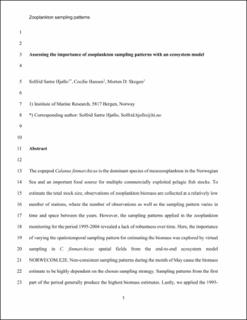| dc.description.abstract | The copepod Calanus finmarchicus is the dominant species of mesozooplankton in the Norwegian Sea and an important food source for multiple commercially exploited pelagic fish stocks. In addition to the patchy distribution of species, the vast size of the Norwegian Sea makes synoptic zooplankton monitoring challenging. Monitoring includes relatively few sampling stations, and the number as well as the geographical location of these vary in time and space among years. In the present study, we explored the sampling patterns in 2 existing datasets: (1) for the period 1994-2004: size-fractionated zooplankton biomass, which allows for estimation of C. finmarchicus fractions, at irregularly spaced locations, and (2) for the period 1995-2017: non-size-fractionated zooplankton biomass data, gridded by objective analysis. We first assessed the C. finmarchicus data set by virtual sampling in C. finmarchicus spatial fields from the end-to-end ecosystem model NORWECOM.E2E. We found that non-consistent sampling patterns during the month of May caused the biomass estimate to be highly dependent on the chosen sampling strategy: sampling patterns from the first part of the period generally produced the highest biomass estimates. We then assessed the gridded zooplankton dataset by applying the 1995-2004 sampling patterns as well as a recent (2020) sampling pattern, which included regular and more numerous sampling locations, and found systematic differences. We conclude that the present May sampling pattern is much more robust and thereby also more likely to provide a good estimate of the interannual variability of the total biomass in the area. This study is an example of how models can be used to mechanistically interpret experimental datasets, and more specifically, how models can be used to assess sampling patterns and reveal their limitations. | en_US |
